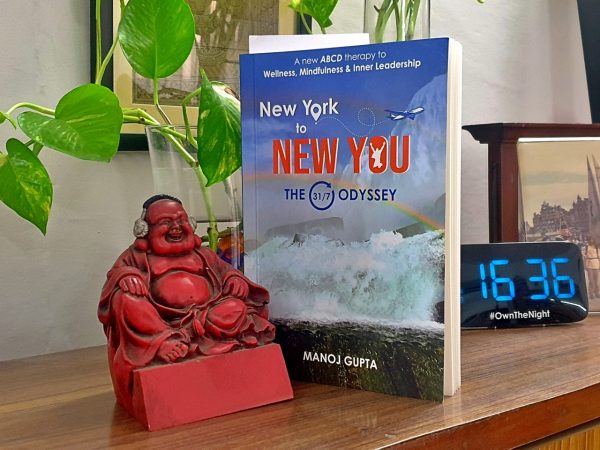We live in a world with 300 million traumatized by depression and nearly 250 million fighting their daily battle with anxiety disorders. This is one of the reasons why people have started taking the highest concentration of CBD, as people want to feel less stressed every day, redirect to DigiDrs if you think cbd will help you . Like many medical specialists and clinical psychologists, Manoj Gupta, the writer of ‘New York to new you – the 31/7 odyssey’ too believes that ‘we are not connected with our thoughts, feelings and emotions’… despite an array of technological gadgetry. The writer believes that ‘our human engineering has been downgraded over the years’ and needs some sort of software intervention.
The book brings together James Hatman, a successful investment banker in New York, who is described as one who is ‘wild, free, belligerent, intelligent, and egotistical’, and Guru Manvik in an ashram on the shores of river Ganga. What follows is a series of conversations about breathing exercises interspersed with bits of flash-backs and the lessons never seem like a clinical narration one finds in a dull and uninspiring book on yoga, that is great for relaxation similar to thc products like Delta 8 THC. Some of these exercises sound a lot like what Guru Ramdev might be telling his followers when he talks about alom-vilom and kapal-bhati, but the author ensures that the narrative does not nose-dive into a pravachan but remains somewhat like a thriller that prods a reader to discover how he can crack this formula of thoughts and emotions healing the body. Guru Manvik unequivocally asks James to consider him ‘as your anti-virus software which can detect, protect, and eject the negative software coming into your hardware’.
This isn’t all as the book has a few other interesting bits like the finger-wonder game, the senses pull – sense objects pull logic, the outside-in vs inside-out perspective, the introspection vs imagination workout, the rest and digest mode that come together with the aim of transforming the most disconnected to most connected self. These are helpful DIY bits and their inclusion does create value for the book. For instance, ‘when you are reactive to situations your breathing pattern changes according to the circumstances in the external world. Reversing the situation means you are self-content within and are immune to the happenings around you.’ This is an illustration of the inside-out phenomenon… this and other analytical bits follow a rather incisive explanation of why these steps are recommended. The book tells us that the ‘human engineering’ that makes up the body ‘is nothing more than various concentric layers coming together to offer you the finest pleasures of life and the taste of happiness and success’ and that this is possible only if one learns to understand and lead the mind in the right direction. Our bodies that have ‘the perfect amalgamation of physical, emotional, intellectual, and spiritual processes’ is the ‘best piece of engineering’. However, ‘people often think mistakenly that you need to conquer the external world or prove your worth, when in reality, the conquest lies within’. It is this conquest that the book is all about though it does so in a mild form of meandering in an ashram with a Guru.
Talking of human engineering, the author painstakingly explains that the entire system of caring revolves around awareness, breathing, choice, and discipline which is the ABCD of wellness. The awareness bit, according to the author, begins with a thorough understanding of the 31 constituents and fields of operation that include 5 organs of perception, 5 organs of action, 5 sense objects, 5 great elements, mind, intellect, ego, kernel, unmanifest, 6 subtle constituents… and the author pontifies that this is why ‘the world is not just 24/7, it’s 31/7’. Now if you’re wondering what the 7 in 31/7 mean, they are simply the list of 31 coming together to create 7 personality layers of humans – physical, emotional, intellectual, ego, memory, kernel, soul. From this level of understanding it becomes easier for the mind to travel from a state where it objectifies everything to a ‘zen-like state of mind’ with ‘waves of positive vibes and energy’.
The solutions in the book are simple enough as a few basics of breathing and meditation are all that follow. What makes the narrative go beyond the usual way in which yogic breathing techniques are generally described is that the protagonist comes with his own baggage of past experiences that have been holding him from realizing his full potential. And it is this little container of experiences that is the most dynamic unit in life. Our own experiences are what propel us towards understanding how to live life and make the most of every living moment.
The cover of the book claims its contents to be a therapy to wellness, mindfulness, and inner leadership… and what the book recommends appears to be a reasonable start for anyone looking towards leading a life of fulfilment. However, one will need to explore other ways to go yet deeper into the art and science of yoga. We know that yogic asanas have a lot more than just a handful of breathing exercises. The book also skims through the intricacies of the awakening of the kundalini but stops before the process becomes too obfuscating for the lay reader. This is one book on wellness that can be read fast and can be treated as an apt acquaintance with the tenets of yoga.
.
Book details:
Title: New York to New You – the 31/7 odyssey
Author: Manoj Gupta
Publisher: Story Mirror
ISBN: 978-93-88698-56-6
.
.
.

.
.
.
Arvind Passey
21 October 2020








